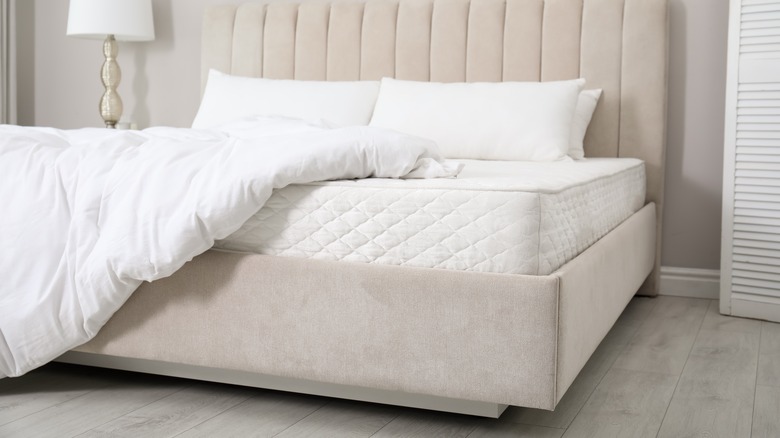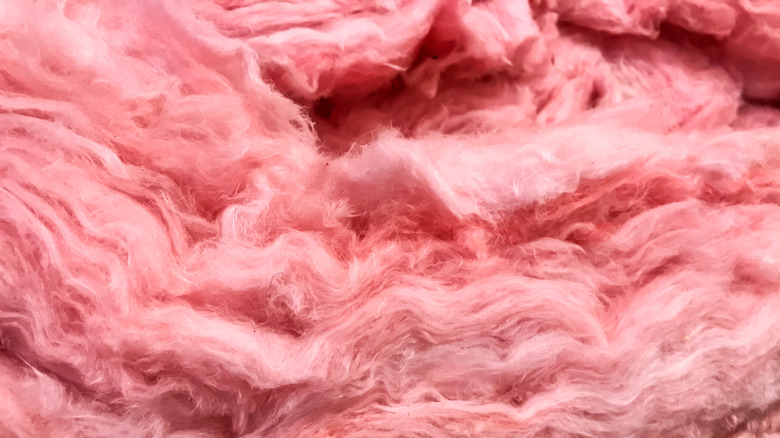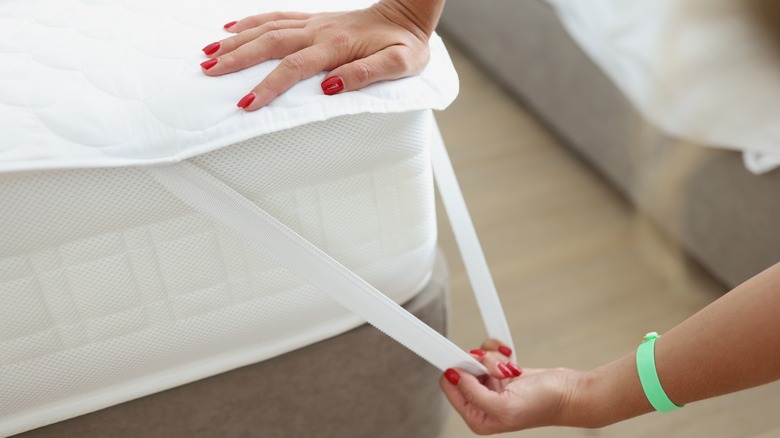Why You Should Avoid Buying A Mattress Containing Fiberglass
While sleeping soundly on your new mattress, you may be blissfully unaware you are potentially being exposed to hazardous fiberglass. You might expect home insulation, boats, swimming pools, or auto parts to contain it, but mattresses? The flame-resisting qualities of fiberglass prompted its widespread use in mattresses and mattress covers in response to safety guidelines established in 2007 by the U.S. Consumer Product Safety Commission. It is also inexpensive and more cheaply mass-produced than other materials used for that purpose. Fiberglass is a composite material that, according to VPC Fiberglass, consists of resin and glass fibers. Invention & Technology traces the use of glass fibers for decorative purposes to ancient civilizations. In 1932, stretched and melted glass was first used by Owens-Corning for insulation.
Exposure to fiberglass has been associated with various health problems. The International Journal of Environmental Research and Public Health reports that the harmful effects of fiberglass are particularly problematic for children and infants. Direct contact with the material is dangerous and requires safety clothing and eyewear when working with it. Should fiberglass be released from a mattress, it may be beyond the reach of a DIYer and result in costly professional intervention. Temporarily vacating the premises may even be necessary. Manufacturers insist that as long as fiberglass does not leak from a mattress, it is safe to use. However, ensuring that it remains contained is another matter. Several class actions attest to the possibility of hazardous consequences from exposure.
How does fiberglass harm you?
According to Poison Control, prolonged contact with fiberglass can cause several respiratory issues, including pulmonary fibrosis. In the short term, it may result in lung irritation, aggravate asthma, or cause digestive problems. Cuts, welts, and rashes can also occur from breathing in fiberglass, touching it, or ingesting it. Medical News Today attributes a condition known as fiberglass dermatitis to having pieces of the material embedded in one's skin. Per the Illinois Department of Public Health, small fiberglass fragments are of particular concern due to their ability to penetrate the lower lung area. Sleeping on a synthetic-laden mattress may also generate excess heat and negatively impact sleep quality. Fortunately, fiberglass is not considered to be a human carcinogen.
A suspiciously low price might be a giveaway that a mattress is tainted, and Sleepopolis suggests steering clear of any that cost less than $600. The Sleep Shop advises that some imported mattresses, especially those made in China, may contain fiberglass. Instead, seek a mattress containing organic alternatives that are also flame resistant, such as coir, hemp, wool, or natural latex. Fiberglass has a long life span, and a discarded mattress containing it will take eons to biodegrade in a landfill.
How to prevent fiberglass contamination
Never remove your mattress cover, as this is an invitation to contamination. Fiberglass that escapes from a mattress requires a thorough response, as it may combine with the dust in your house. Repeated vacuuming and washing all surfaces is necessary, and running an air purifier is a good idea. Do not put a mattress cover or contaminated clothing into the washing machine. Fiberglass shards in a mattress are tiny and numerous. According to Top Class Actions, should they infiltrate a home's HVAC system, a pro might be needed to the tune of up to five figures.
Before purchasing, always check the label to research the contents of the mattress. However, unethical manufacturers have been known to use evasive terminology, and roundup.org warns that "glass fiber," "glass-reinforced plastic," or "glass-fiber-reinforced plastic" may be aliases for fiberglass. When in doubt, contact the manufacturer to determine if a mattress contains fiberglass. Buying organic lessens your chances of sleeping on a bed of the stuff. If your mattress has it, investing in a mattress topper is an excellent way to help seal and protect it from the wear and tear that might release the fiberglass. The Washington State Department of Health asserts safe fiberglass exposure is not to exceed 1 breathable fiberglass per cubic centimeter of air. Undoubtedly, avoiding fiberglass is one way to live a healthier lifestyle.


